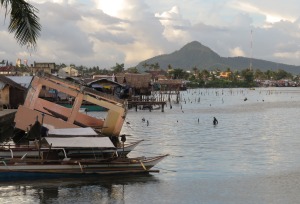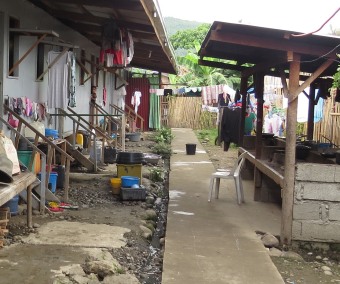Dr. David Cobley is a teaching fellow in IDD where he has established a module focused on disability and development. Previous research has examined economic empowerment strategies for disabled people in Kenya, India and Sierra Leone. David has worked in the field of disability for 23 years, including setting up a care home for adults with learning disabilities.
Super Typhoon Haiyan (known locally as Yolanda), the strongest typhoon on record ever to make landfall, ripped across the heavily-populated central Philippine provinces on 8th November 2013, leaving a trail of death, devastation and shattered lives in its wake. According to official sources, over 6000 lives were lost, over four million people were displaced and over 16 million people were affected by the destruction of infrastructure and breakdown of basic services across 44 provinces. For the Philippines, a country once described by its former president, Gloria Macapagal-Arroyo, as a ‘laboratory of major disasters’, this was a natural disaster without precedent in terms of scale and impact.
One year on, at the time of my visit to the Philippines, many people were still struggling to cope with the catastrophic consequences of Haiyan. Much of the devastation occurred in the Eastern Visayas region, with Tacloban City bearing the brunt, at least in terms of casualties. I arrived in Tacloban to discover that, despite worldwide attention being focused on this city for several weeks immediately following Haiyan and the inevitable influx of humanitarian agencies, the reconstruction efforts appeared to have been piecemeal and painfully slow. Far from ‘building back better’, many people were still waiting for building back to begin at all. This was being widely attributed to the Government, as many of those that lost their homes were still awaiting long-promised Government rebuilding grants and relocation land. Local media were highlighting the issue, estimating the numbers still living in tents and temporary shelters, often located in hazardous ‘no-build’ areas close to the shore, at close to one million across the Visayas. The precarious nature of their situation was highlighted just a few days ago, when Typhoon Hagupit caused considerable damage to these coastal settlements, although thankfully there was no accompanying storm surge this time around.
My objective was to investigate Haiyan’s impact on disabled people, as well as to examine the extent to which they have been able to actively participate in recovery and community rebuilding processes. The strong desire of disabled people to participate in my research was quite staggering at times. One morning I travelled with an interpreter to the coastal town of Tolosa to interview two beneficiaries of an NGO ‘cash for work’ programme, which had provided 18 days’ paid work clearing storm debris. When we arrived at the bus stop, we were met by the two beneficiaries together with several other disabled beneficiaries of the programme that had heard about my visit and also wanted to be included. Consequently, the whole day was spent conducting interviews, under the shade of a nearby wooden shelter, with some participants waiting several hours for their turn. All appreciated the opportunity to participate in the relief operations, enabling them to bring much-needed cash into their households as well as supporting their communities at a time of crisis. One even commented that he considered it a challenge to show that he could work harder than his non-disabled colleagues. Importantly, those that were unable to cope with hard physical labour had been assigned alternative duties, such as office work, carrying water to the other workers or watching over the store room, demonstrating that ‘cash for work’ programmes can be inclusive if designed flexibly.
I came across other examples of meaningful participation, including one project in Iloilo Province in Western Visayas, which involved members of a disabled people’s organisation setting up and running their own relief operations, with fairly minimal technical assistance from an international NGO. The group had carried out a range of activities, from an initial mapping exercise and recruiting volunteers (including many disabled people) to organising the delivery of relief aid packages and providing referral services to nearly 4,000 vulnerable households. With the relief phase drawing to a close, they were now turning their attention towards longer-term development activities in the areas of livelihoods and health.
Memories of the typhoon (referred to by one interviewee as ‘the monster’) were still very raw, so I kept my questions as general as possible, in order to avoid opening up wounds that were still healing. Some wanted to talk about their experiences when the typhoon struck, however, and a number of harrowing survival stories emerged. One wheelchair user, for example, described how he had floated in the rising water clinging to a water can for over an hour, until his nephew found him and carried him on his back to the Barangay Hall, where he lived for one month before moving into a tent close to his destroyed home. Community interdependence is strong in the Philippines, as in many countries of the Global South, and many of those interviewed had survived only due to the support of their relatives and neighbours.
The interviews also highlighted particular difficulties that disabled people may face when they are displaced from their familiar surroundings, as in the case of one young lady with a visual impairment, who had moved to a neighbour’s two-storey house when her home was badly damaged:
“We stayed in the big house for one month, sleeping there at nights and going back to our house in the day. It is hard to lie in a house that is not yours, especially as a blind person. I was disorientated and could not move around freely”
Those with mobility impairments also experienced particular discomfort when displaced from their homes. This was highlighted by a visit to one of the many bunkhouses which served as emergency shelters following Haiyan, and which were still inhabited by many families as they await permanent resettlement. Each of these plywood bunkhouses are split into 24 family units, with a communal kitchen and washroom, and it was clear that very little thought had been given to accessibility. Entrance doors were routinely three steps off the ground, due to the risk of flooding, and the washrooms were far too cramped to enable a wheelchair user to comfortably make use of them.
As well as demonstrating that disabled people can actively participate in disaster recovery processes at various levels, ranging from individual participation in relief operations to the planning and delivery of relief and development services for others, this research helped to reveal some of the particular issues faced by disabled people in the aftermath of a major disaster. These will be among the themes to be explored in a future journal article.


